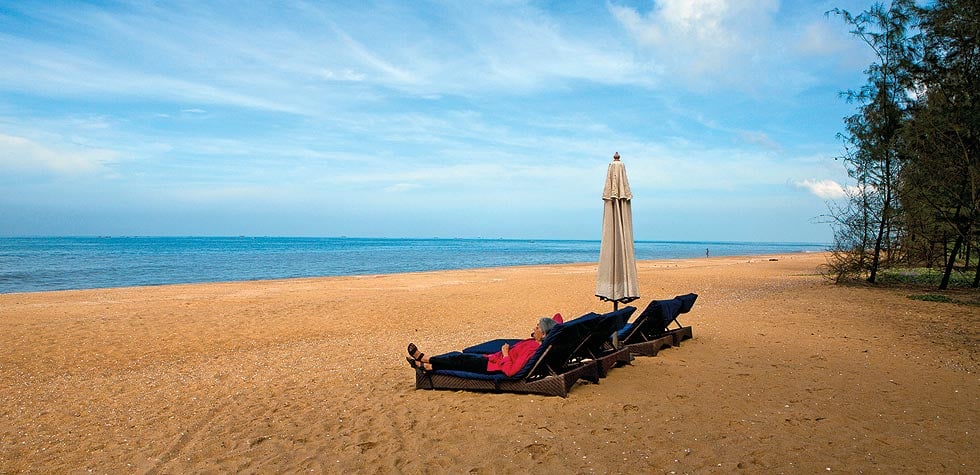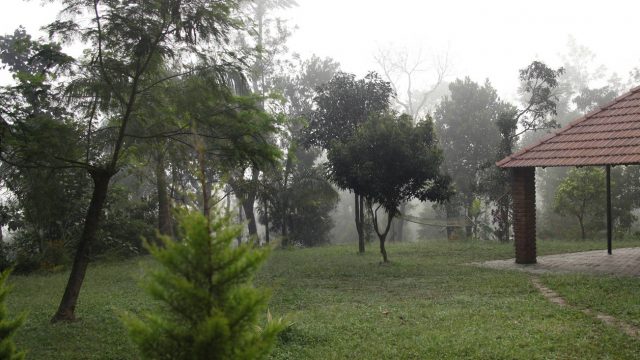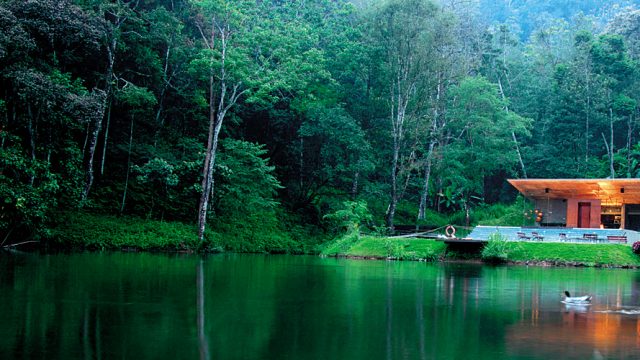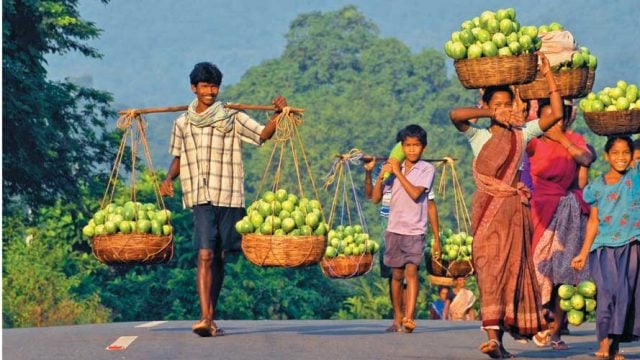A cold and wet coming we had of it… By the time we landed in Calicut after
Thick evergreen forests of rosewood, venteak and rubber surround the resort and line the highway. Here and there, the wooded hillsides are dotted with the brilliant red flowers of the Indian coral tree (Erythrina variegata) and the African tulip tree (Spathodea campanulata), now in full bloom. Tea gardens and coffee plantations cover the lower slopes of the hills, and glimpses of tile-roofed bungalows are visible deep inside the plantation estates. The soft green of paddy fields (Wayanad means ‘land of paddy’) covers the foothills.
Wayanad has Kerala’s largest population of tribal people, each tribe with its distinctive culture. That afternoon we clamber down grassy slopes and wade across streams to reach a small settlement of the forest-dwelling Paniya tribe, on the edge of a coffee plantation. It is a pristine oasis in the midst of dense vegetation: spotlessly clean bamboo-and-mud-plaster huts with thatched roofs; carefully tended vegetable gardens growing ash gourd and pumpkin, pepper vines, turmeric, ginger and tapioca. The only decoration in the hut of the family we visit — and the sole sign of the 21st century — is a picture of Deepika Padukone cut from a magazine and stuck over a small mirror. The family is busy fashioning bamboo staves into fishing rods, and later that day the men will set out to angle in the stream that surrounds their hamlet .
From here we carry on to the Edakkal Caves, about 30 km (an hour’s drive) away. In 1901, the then Superintendant of Police of the Malabar district, Frederick Fawcett, found a Neolithic stone axe during a hunting expedition in the Ambukuthy hill, leading him to explore the site more extensively. His efforts were rewarded by the discovery of these caves, covered with rock engravings (petroglyphs) of human figures, animals, trees and flowers, wheeled carts, stars and geometric symbols. Archaeologists have dated these rock engravings to the Neolithic period, between 4000 and 1000 BCE. There are also inscriptions in Tamil Brahmi incised into the rock, from a later period. It’s a steep 40-minute climb up to the cave from the roadhead, beyond the capacity of your elderly reporter, but a cakewalk for my colleague Ahtushi who is not only a seasoned mountaineer but also an expert on rock engravings, which she has documented in Ladakh. Ahtushi returns with the information that the cave was formed when a large rock fell on two rocks below it, forming a cave-gallery about 90 feet long and 20 feet wide, lit by natural light from a gap in the roof. The engravings are spread over an area of 500 sq feet on the two walls of the cave. She also comes back with stunning photographs, including one of a man with a towering head dress — an imposing figure, exuding power and authority.
In the evening, back at the Vythiri Village, that Neolithic man with the tall head-ornament reappears in his present-day avatar. A performance of Theyyam, the famous ritualistic dance form of north Kerala, has been arranged by the dynamic resort owner, Mr N.K. Mohammad. Theyyam performers are Dalits, and during the performance they take on the form of the gods in a ritual that lasts through the night. At the end of it, they bestow divine blessings on the entranced audience. As darkness falls, a hypnotic drumming begins, Suresh Babu Panangad completes his elaborate make-up, dons his elaborate costume with its tall head-dress, and the mild-mannered villager is transformed before our eyes into a figure with an awesome aura — Shiva doing the tandava nritya, the dance of creation and destruction. To his skirt of swirling palm fronds are attached flaming torches and he stamps his feet, utters fearsome sounds and walks on embers as he whirls at a dizzying speed within his circle of fire. It is a spell-binding experience of the kind that stays with one forever. One wonders if that imposing Neolithic chieftain in the Edakkal caves was depicted performing a similar ritual.
The next morning we discover an unexpected facet of Wayanad’s historic heritage. A significant community of Jains has settled here, most of them originally migrants from Karnataka when Jainism went into a decline there some 800 years ago. Among the several Jain temples in Wayanad, we choose to visit a ruined one at Panchavayal, dating to the 13th century. Driving along winding forest roads lined with teak and rubber trees, we arrive there to find a heap of tumbled granite blocks covered with carving lying by the side of the road and blocking access to the three roofless temple mandapas, their pillars too ornamented with curvaceous yakshis, fierce dwarapalas and amorous figures. The day before, a crew had arrived with heavy excavating machines and proceeded to demolish the temple as part of a road-widening project — a case of ‘infrastructure development’ carried out with appalling zeal, which was fortunately stopped by outraged locals before the entire temple was brought down.
Inside the large plantation estates we experience another side of the Wayanad way of life: of elegantly appointed bungalows, gardens fragrant with flowers and tables laden with the rich bounty of the land. One such estate is Ranjini and Rajagopal Menon’s Wayanad Coffee County, which also offers homestays. The vivacious Ranjini, the great granddaughter of the last Zamorin of Calicut, is a fount of knowledge on north Kerala’s culture, customs, tribes and cuisine. An invitation to lunch at her home spreads over six hours as we explore her 12-acre tea, coffee, coconut and areca palm plantation; see her cows, ducks, geese, turkeys and emus, and her kitchen with its traditional stone and brass cooking vessels and enormous grinding stones. Her courtyard boasts a swimming pool, and leads on to a pavilion perched over a gurgling rivulet. From here one can see Mount Chembra, the highest peak in the region, its summit usually cloaked in clouds. The waxy red blossoms of the African tulip tree frame the pavilion. The tree isn’t native to this region, it was introduced by the British because it attracts mosquitoes and keeps them away from human habitation.
What a lunch is laid out in the pavilion! We feast on pathiri (rice pancakes), meen mulakittathu (fish curry), varataracha mutton (Malabar-style mutton), banana flower thoran and steamed tapioca to soak up the gravies, all bursting with the flavours of the freshest pepper, cinnamon, cardamom and coconut from her estate. To end, there’s a delicate dessert called elaada — rice and coconut milk pancake stuffed with jackfruit jam and steamed in a banana-leaf wrap. An array of homemade pickles and chutneys accompany the meal. See recipe http://www.outlooktraveller.com/article/Recipes-from-Malabar-1006764#15024
An ayurvedic massage at the excellent spa at the Vythiri Village Resort helps us work off the sloth induced by overindulgence at Ranjini’s lunch. It is our last evening at Vythiri, and the indefatigable Mr. Mohammed has gathered together a group of young people from different tribes in the area to perform their traditional dances. A particularly poignant one tells the story of a young tribal girl who, when she attains puberty, is taken decked in her bridal finery to the local landlord so that he may have the ‘first taste’ of her.
The next morning we leave the mist-shrouded hills of Wayanad and head down to the plains, a five-hour drive to Kerala’s northernmost district of Kasaragod, bordering Karnataka. We cross rivers and backwaters and, as we near Bekal, breathe in the distinctive scent and bracing air of the sea. The massive laterite stone battlements of Bekal Fort rise from the sea, its watch tower providing a panoramic view of the sea and the surrounding countryside. Below the fort is a small fishing village, with its fleet of little boats. Built in 1650, and later taken over and extended by Tipu Sultan, Bekal Fort has no palaces or buildings, just that massive wall of stone to protect what was once an important port, from maritime invasions.
A few kilometres down the coast from the fort is the luxurious Vivanta by Taj hotel, its 26 serene acres facing the sea and bisected on one side by the backwaters of the Kappil river. The backwaters here aren’t deep enough for houseboats, but there’s canoeing on offer, biking trails, yoga sessions and a luxurious spa. We try the traditional Kerala sadya lunch served on a banana leaf, expertly prepared in the hotel kitchen every day by local housewives. A leaflet handed out with the meal urges us to eat with our hands because each finger is an extension of the five elements and these enable us to get the full benefit of the food. The thumb, it tells us, is agni (fire) and aids digestion; the forefinger is vaayu (air); the middle finger is akaash (ether); the ring finger is prithvi (earth); and the little finger is jal (water). Ahtushi and I use our five fingers, first to dive into the food, and then to do an enthusiastic high five for north Kerala’s fabulous cuisine, its warm and gifted people, and its wealth of natural beauty.
The information
Getting there
There are daily flights to Kozhikode (Calicut) from major cities — Air India flies from Delhi via Mumbai and Coimbatore. Several trains, such as the Rajdhani from Delhi and the Poorna Express from Pune, go to Kozhikode. From Kozhikode, Vythiri in Wayanad is around 2 hours (66 km) by road. It is 5 hours (287 km) by road from Bangalore, 2 hours (149 km) from Mysore and 3 hours (107 km) from Ooty.
Bekal is a five-hour drive from Vythiri, the last 25 km along the coast. The nearest railhead and airport is Mangalore, 80 km from Bekal. Jet Airways flies to Mangalore from Delhi via Bangalore, and from Mumbai. The Trivandrum Rajdhani from Delhi and the Ernakulam Duronto Express from Mumbai are connected to Mangalore.
Where to stay
Wayanad
We stayed at the Vythiri Village (+91-4936-256716, vythirivillage.com) sprawled over 28 acres, surrounded by thick forest and teeming with birdlife. The grounds have streams, a waterfall, nature walks and a Zipline especially popular with visiting techies from Bangalore and Mysore fulfilling their Tarzan fantasies as they swing over streams and forest to a waterfall. There’s also a swimming pool, an excellent Ayurvedic spa, and a huge convention centre with a state-of-the-art auditorium with a capacity of 1,500.
The food is outstanding and the rooms are spacious. There are 12 cottages, 36 deluxe rooms and 26 suites. Some 40 pool villas will soon be ready. Tariffs: From Rs 8,500 to Rs 10,500 doubles, with breakfast for a cottage; and up to Rs 23,000 with breakfast for the pool villas, which are currently under construction.
Wayanad Coffee County (Rs 5,000 for a room in the bungalow and Rs 4,000 for the cottage, wayanadcoffeecounty.com), a homestay in a beautiful 12-acre tea and coffee plantation run by Ranjini and Rajagopal Menon, is another excellent option. The energetic Ranjini organises cooking lessons, visits to tribal villages, cultural performances, plantation walks and birding. There are 3 spacious rooms with attached bathrooms and two cottages available.
Bekal
We stayed at the Vivanta By Taj (from Rs 10,000 per room and upto Rs 30,000 for the villas; vivantabytaj. com/bekal-kerala) by the Kappil beach and backwaters. The hotel has 22 villas. The heavenly villa in which I stayed had its own pool, a verandah facing the backwaters, an outdoor bath and shower and a courtyard with a swinging daybed.
What to see & do
Wayanad
Visit the picturesque Pookode lake surrounded by wooded hills, 3 km from Vythiri, and if the weather is clear take the 5 km walk around the lake. Buy spices and tea fresh from the plantations at the stalls at the lake entrance. Trek up to the Edakkal Caves with their intriguing rock carvings, shop for fine Kerala saris and other handlooms at Sindur in the nearby town of Kalpetta. Go on an early morning nature walk with a knowledgeable local to point out local flora. With a bit of patience, you’re almost sure to see the giant red Malabar squirrel.
About 2 hours away is the ancient many-pillared Thirunelly Temple beside the Papanasini river, a famous pilgrimage centre. Tip: Take an umbrella and raincoat. The average rainfall in Wayanad is 2,300mm, and there are two monsoons — June-September and October-November.
Bekal
Visit Bekal Fort, its formidable battlements rising out of the Arabian Sea, and the fishing village below it. Guests can accompany the Taj chef to a nearby fishing village to buy the fresh catch. The hotel also organises river cruises at Nileshwar 25 km away, treks through coconut plantations in the neighbourhood, yoga sessions , biking and canoeing.
Edakal Caves
Kerala
Malabar hornbill





